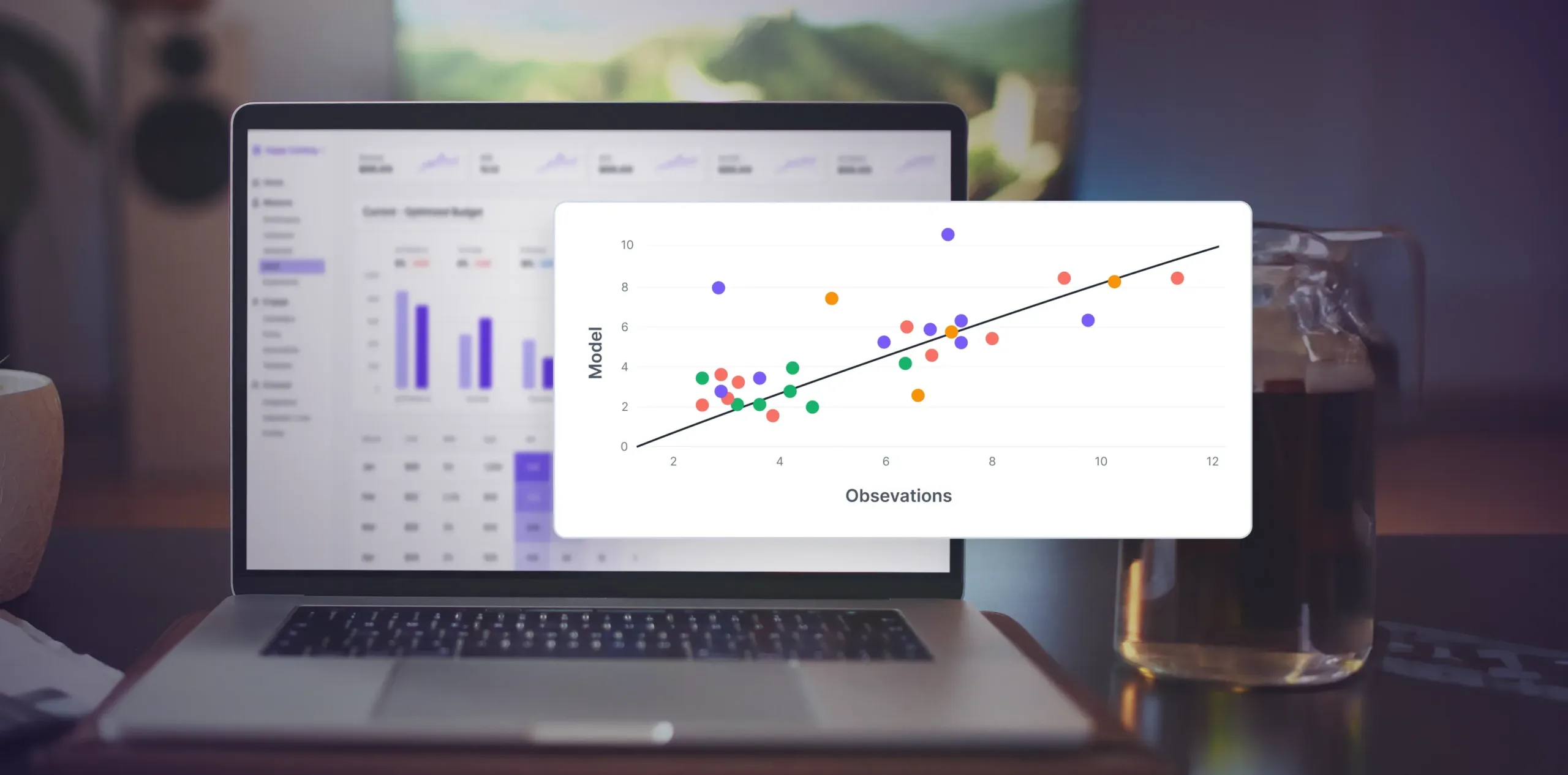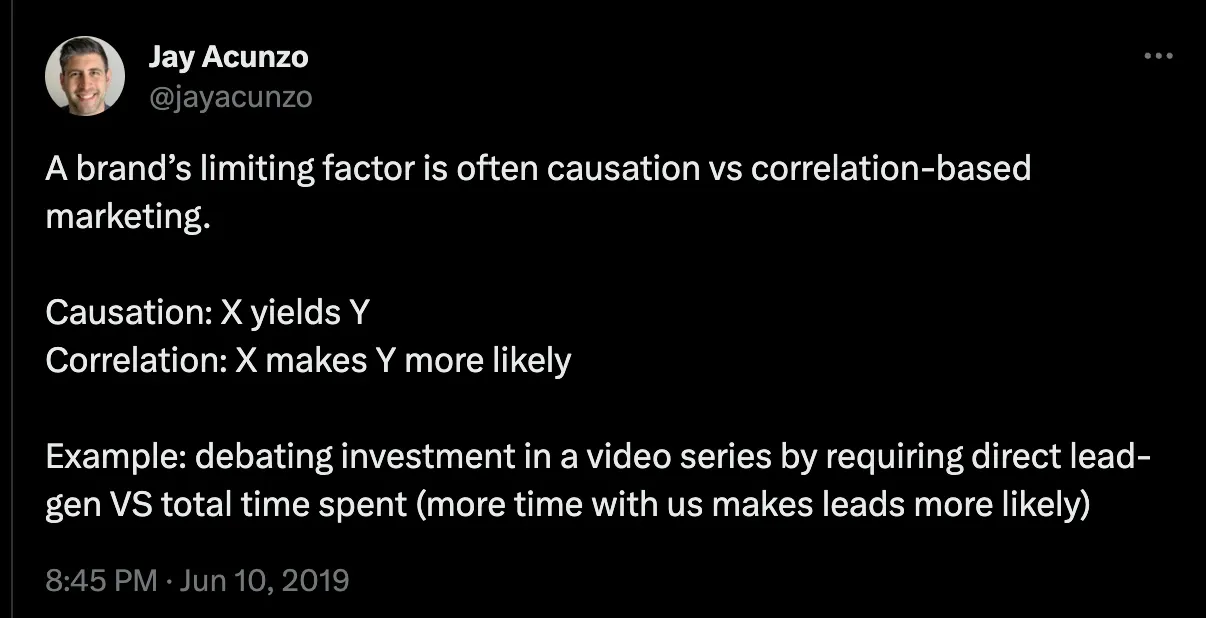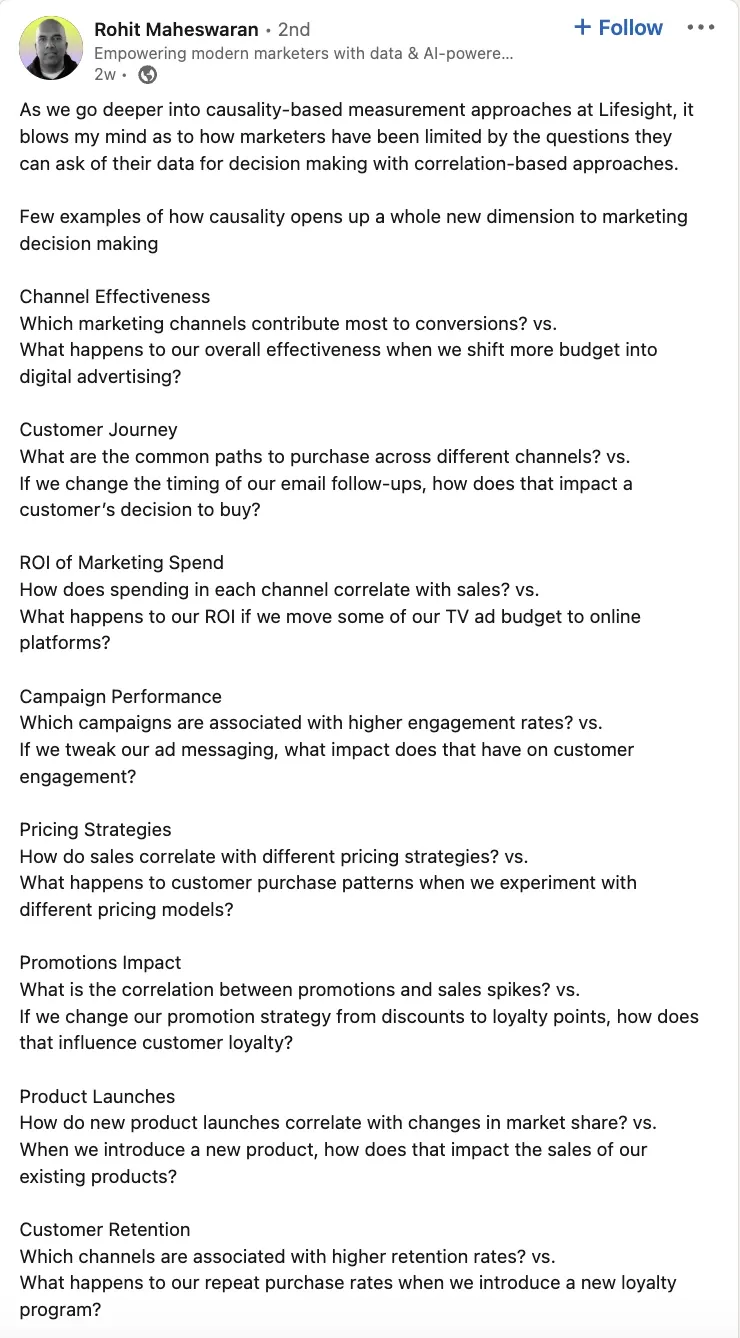Understanding the subtle differences between correlation and causation is pivotal in marketing analytics.
Consider a scenario where you launch a Christmas campaign and subsequently witness a surge in sales. This situation might initially seem like a clear case of causation – the campaign (cause) directly leads to increased sales (effect). However, it’s crucial to delve deeper to ascertain whether this relationship is purely causal.
However, the picture often gets more complex. Other factors, such as a seasonal increase in shopping or significant discounts, could also contribute to this sales uptick. This scenario typifies correlation, where multiple interconnected variables collectively influence the final outcome.
Marketers who understand the difference between causation and correlation can better discover the actual drivers of a campaign’s performance.
Correlation and causation are cornerstone concepts in strategic marketing decision-making, essential for analyzing buying patterns, targeting consumer interests, and formulating customer engagement strategies.
In this article, we discuss what is correlation vs causation and the best practices to get the most out of them.
What is Correlation?
Correlation, as observed in methodologies like Marketing Mix Modeling (MMM), explores the relationship between different factors and outcomes without relying exclusively on customer data. While traditional MMM takes a statistical route to uncover relationships between various internal and external factors and their collective influence on specific outcomes, it doesn’t inherently establish cause and effect. However, the model can be enhanced to approach causality when calibrated with incrementality data.
Incrementality data provides insights into the actual lift that marketing efforts contribute, beyond what would have occurred without the specific campaign. By integrating incrementality insights, MMM can be transformed into a more causal model, allowing marketers to attribute outcomes to specific actions with greater confidence.
For example, in the above scenario, the correlation approach would show that A is not the only reason behind the outcome B for the same store. There is another factor called C, which defines seasonality. That means Instagram sales of a brand increased in February because of running more ads and the increased shopping tendency of the customers due to Valentine’s Day.
Clearly, with a correlation approach, you cannot hold a single factor responsible for an outcome. Consider other relevant factors like recession, inflation, political stability, seasonality, and similar statistically relevant trends that directly or indirectly influence a buyer’s purchase decision.
What is Causation?
For omni-channel marketing campaigns with multiple touchpoints, it is difficult to figure out what caused the outcome of a marketing campaign. With causation, marketers predict the “why” or root cause behind specific campaign outcomes.
Marketing leaders use the concept of causation to understand the direct influences of different marketing initiatives and channels on the overall ROI of an organization.
For example, a retail store noticed a sudden surge in Instagram sales in February. If the outcome (B) is an increase in sales through Instagram, the causation approach will show you that the reason (A) behind this outcome is an increase in Instagram ads budget.
Correlation vs Causation Difference?
If two variables have a cause and effect or causal relationship, in that case, causation and correlation are synonymous. However, when a third variable is present, it is not always true that there is a directionality issue or possibility of a chain reaction.
Jay Acunzo, co-founder at Creator Kitchen, shares a real-life dilemma of marketers deciding between causation and correlation.
real-life dilemma of marketers deciding between causation and correlation post by Jay Acunzo
Below are the scenarios where correlation and causation are not similar and the concept of correlation vs causation comes into the picture:
- When there is a third variable, it is difficult to estimate the impact of each variable on the outcome. A third variable influences the first two variables distinctively, and it is impossible to establish a cause-and-effect relationship between the outcome and the three variables with causation.
- The cause is generally the independent variable and the effect is the dependent variable. But in some instances, there are directionality issues between these two variables, and hence, causation fails in these scenarios.
- There are situations where multiple variables develop a chain reaction among each other, and there is no single way to define a cause-and-effect relationship. In these cases, marketers conclude that those variables are correlated.
How Causality Unlocks Decision-Making in Marketing?
Marketing leaders ultimately seek to answer the “Why” and “How” behind strategies, concepts, and campaigns.
- Why has this campaign tanked, and how do I improve its performance in the next quarter?
- Why did this campaign perform well, and how can I replicate success?
While correlation cannot answer your questions definitively, causality will.
Here’s how causality simplifies decision-making for marketing leaders.
Predict hypothetical situations to improve strategy
With causality, there is no room for guesswork. If you allocate an extra 10% of your budget to your LinkedIn campaign, you know the possible outcomes.
It is no longer a trial and error process where you increase the budget across all channels and observe that only LinkedIn gives you the desired ROI, and other channels like Facebook, Instagram, and Google Ads could be doing better.
Rather, causality helps you find answers to:
- Which marketing channel contributes to conversion, and in what proportion?
- What are the possible changes expected in the overall campaign ROI when you cut the budget from one channel and allocate it to another?
Rohit Maheswaran, the co-founder at Lifesight, explains the untapped potential of causal marketing in his LinkedIn post.
Rohit Maheswaran explains the untapped potential of causal marketing in his LinkedIn post
Cut down expenses on non-incremental value campaigns
The predictions from causality help you identify and remove ineffective campaigns and double down on investment for successful campaigns, contributing significantly to the ROI.
That means your GTM strategy will no longer be a compilation of “if this happens, that will happen”. It will be about pricing, promotion, product, and marketing strategies that list clear outcomes and help you make solid decisions on the next steps.
You will have answers to:
- Which campaign is most profitable, and how will its performance change if you change messaging?
- How is promotion and customer loyalty related? If you remove influencer marketing from the promotional strategy and add a loyalty bonus, how will that affect overall sales?
Develop a marketing roadmap that is informed and free of assumptions
An informed and predictable marketing roadmap will develop a better GTM strategy. With causal marketing, you have all the information about product positioning, pricing, and channel effectiveness.
For example, causal marketing helps you answer:
- How will a new product launch impact the performance of existing products?
- How do purchasing patterns change if you experiment with pricing models?
With all this information, marketers build customized marketing roadmap that can be iterated as required.
Best Practices for Marketers to Implement Causal Marketing
Causal marketing is the collection of in-depth market and advertising research to learn more about the anonymous users engaging with your ads or website, understand their customer journeys, and map a significant cause to all the campaign outcomes.
While causal marketing helps you optimize your existing campaigns to achieve better outcomes, it is a long process to drill down which factors cause which outcomes.
Here are some best practices for marketers to perform causal marketing strategies efficiently.
1) Choose your variables carefully
Picking the correct set of variables is crucial in causal marketing. There should be one dependent and one independent variable, and make sure to define both distinctively so there is no confusion or possibility of correlation.
List the confounding and control variables. The confounding variables are those that may indirectly impact your marketing experiments. The control variables are benchmarks to compare your results.
Suppose you are running both advertisement and email campaigns simultaneously, and the outcome is increased sales.
With causal marketing, you will discover which of these campaigns drives more outstanding sales.
But make sure to list all the other variables, like seasonality, decline in the inflation rate, and discount percentage for both channels, that might influence your increasing sales.
2) Incorporate Incrementality Intelligence Using Experiments
Utilize experimental designs to assess the incremental impact of marketing efforts. This involves setting up tests, such as A/B testing, where you modify one independent variable at a time and observe the resulting changes.
Tools like Google Analytics, Google Ads, and Google Search Console can facilitate these experiments. Monitor how these changes affect outcomes and use the data patterns to shape future organic and paid marketing strategies.
3) Leverage Causal Inference
Apply causal inference methods to more accurately predict outcomes based on your marketing interventions. This approach goes beyond correlation, allowing you to understand the direct impact of specific actions on your marketing goals. Use causal inference to analyze the effectiveness of different channels and tactics, and make informed decisions on where to allocate resources for the maximum return.
4) Build a controlled environment
When conducting a causal marketing experiment, use a controlled environment. This means conducting surveys and interviews and collecting the latest trends and stats to understand the industry standards.
Another great way to develop controlled environments is through A/B tests. Keep changing one independent variable at a time in your marketing software (like Google Analytics, Google Ads, Google Search Console, etc.) to find out how the outcomes are changing. Use these data patterns to plan your next organic and paid marketing strategy.
Conclusion
Both Correlation and Causation marketing are crucial for marketers. CMOs and marketing leaders are responsible for presenting the effectiveness of their marketing initiatives to the board members and interpreting the underlying causes of the success (or failure) of various campaigns.
By learning Correlation vs Causation marketing approaches, drawing meaningful conclusions to establish the effectiveness of a marketing campaign becomes easier.
Conducting causal experiments manually is next to impossible as it involves analyzing large datasets. Marketers may require months and even years to identify the underlying reasons behind a campaign’s performance.
But with Lifesight, getting a transparent overview of all marketing channels in a single dashboard, comparing different attribution models, and finally unlocking the reasons behind how a campaign influences your overall ROI is much easier.
Want to get started with casual marketing with Lifesight?
You may also like
Essential resources for your success


















